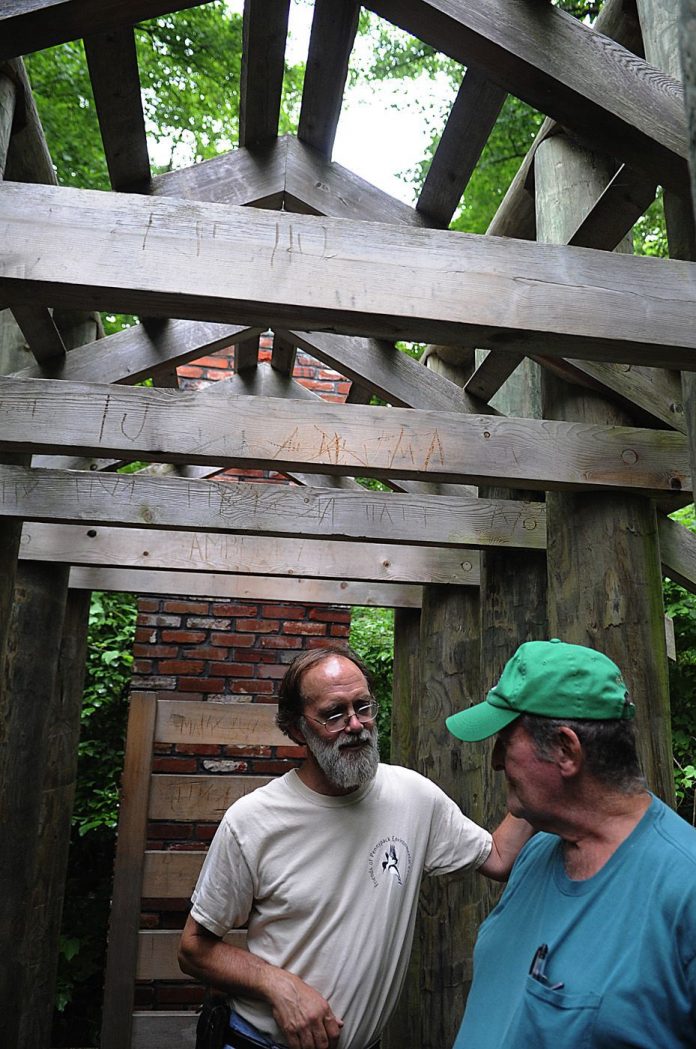Recent events at the Thoreau’s Hut public art installation in Pennypack Park are not the kind of civil disobedience that the namesake 19th century author had in mind when he urged people to challenge unjust government.
For one thing, Henry David Thoreau would never have been caught boozing in the woods on the banks of Walden Pond.
Unfortunately for art and nature lovers, however, many local teenagers don’t share the teetotaling writer’s sensibility for sobriety. Apparently, nor do they respect the thought and effort exerted by artist Ed Levine eight years ago in creating the hut, along with two related sculptures, in the woods behind the Pennypack Environmental Center.
On successive weekends last month, two longtime volunteer park advocates, Jim and Sandy Stewart, found costly vandalism and drinking-related debris at the Thoreau’s Hut site. In response, the couple reported the damage via e-mail to Jim Ryan, vice president of the Friends of Pennypack Park.
Ryan filed a police report and contacted the city’s Department of Parks and Recreation, which had been unaware of any vandalism issues at the site.
The Environmental Center is staffed by Parks and Recreation employees and located on Verree Road, just south of Bloomfield Avenue.
Youths routinely hold nighttime drinking parties during warm-weather months at many sites in the 1,600-acre park — in addition to other public parks, recreation centers, railroad corridors, schoolyards, industrial parks and secluded areas around the Northeast.
They’ve done so for generations.
But this case seems to be different if only because the site in question is truly one-of-a-kind. The Environmental Center’s volunteer advisory committee, with backing from the Fairmount Park Art Association, commissioned Levine, of Vermont, to design and build the art installation in 2003.
“The feeling among the [committee], I think, was there’s very little public art in Northeast Philadelphia,” said Peter Kurtz, the Environmental Center’s youth development and education specialist. “Can you name another one?”
Though owned by the city, the installation is one of hundreds maintained by the Fairmount Park Art Association, a private, non-profit organization founded in 1872 to cultivate public art. A full description of the installation is available via www.fpaa.org.
Thoreau’s Hut is 15 feet high, 10 feet wide and 15 feet deep, echoing the dimensions of the rustic Massachusetts cabin where Thoreau lived for more than two years in the mid-1840s and which supplied the subject, if not the inspiration, for his iconic Walden.
The replica hut is made mostly of wood, brick and flagstone on a concrete foundation and is open to the elements — unlike Thoreau’s real cabin.
It has wooden floorboards, thick pillars, pitched eaves, a couple of wooden benches and a mock hearth.
Nearby installations include Benches, a series of three large wooden structures suitable for sitting; and Bird Blind, a 9-foot-high, 19-foot-wide covered structure offering visitors a concealed view of the surrounding wildlife.
On a June 5 walk in the park, the Stewarts observed empty beer cans and trash at Thoreau Hut, graffiti carved into the wood and remnants of a small fire — as if someone had put flame to a cardboard beer carton.
On June 14, the Stewarts saw more party-related litter. Also, boards from the floor of the hut and benches had been torn out and tossed aside.
A Northeast Times reporter visited the site on June 23 and saw a charred log and more beer containers.
“Kids drinking and the associated vandalism unfortunately is a constant in the park. I have written a letter to the local police district alerting them to this spot and the [park] rangers have kicked a few people out of here,” Kurtz said. “But [the problem] is seasonal and cyclical. [Enforcement] has to be constant. We went through a period of six months or so where we had no drinking.”
In general, the Environmental Center supervisor said, the art installations have not been particularly troublesome spots over the years.
“We have had minor vandalism and maintenance issues,” Kurtz said. “I check these usually once a week.”
One time, however, Kurtz removed Christmas stockings that someone had stapled to one of the hut’s wooden columns.
Barry Bessler, chief of staff to Parks and Recreation First Deputy Commissioner Mark Focht, echoed Kurtz’s assessment of the site as a trouble spot.
“There’s not a pattern to anything we’ve seen in the past,” Bessler said. “I understand a police report’s been taken on this. We’ll take care of any repairs that we’re able to. Anything creating a public safety hazard will be prioritized.”
As part of the Art Association’s maintenance program, a staff member visits each public art site at least once a year to assess and plan any needed repairs, according to Laura Griffith, the association’s assistant director.
“When you put something out in public like that, especially in an area that’s relatively isolated … you know that when something’s in the public realm, something can happen,” Griffith said.
“We do the maintenance, but the city owns them, so it gets complicated.”
Kurtz thinks that the most recent structural vandalism may have been a product of opportunity. Some of the boards that comprise the hut have softened due to moisture. Several floorboards sag underfoot.
“You’re talking kids and talking opportunity,” Kurtz said. ••
Reporter William Kenny can be reached at 215–354–3031 or [email protected]





